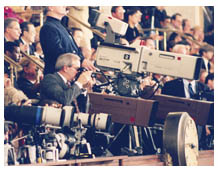Speaker Joe Martin's Television Debut:
The House of Representatives and Television
Nearly a half century elapsed from the invention of television to the broadcasting
of House Floor proceedings. During the 1920s and 1930s, technological innovations
allowed the transmission of images via radio waves. Television receivers first were
sold to the public in 1939—though regular network programming did not begin
for another decade. The first live television broadcast coverage of a congressional
proceeding occurred on January 3, 1947, when cameras were allowed into the House
Chamber to telecast the opening of the
80th Congress. It also was the last such broadcast for more than
three decades, despite the fact that television became a major cultural phenomenon.
Between 1949 and 1962, for instance, the percentage of American homes with television
sets sky rocketed from about two percent to 90 percent.
At first, Congress utilized the new technology sparingly. In the House Chamber,
cameras occasionally telecast major speeches by Presidents and visiting dignitaries,
but by 1952 they were banned not only from regular floor sessions but in committee
hearings as well. Concern centered on television's effect on institutional practices
and procedures: Which aspects of House proceedings should receive coverage? Who
would make that determination? Who would operate and control the cameras? How would
Members respond to working under the gaze of the cameras?
Post-Watergate reforms and a new spirit of transparency and accountability in government
provided the momentum necessary for supporters of televised proceedings. In March
1977, Speaker
Thomas “Tip” O'Neill of Massachusetts authorized a three-month
closed-circuit testing period. Within a year, the House had passed measures to approve
televised proceedings and fund the establishment of its own television system—thereby
answering the critical question of who would control broadcasts. On March 19, 1979,
public television and the C-SPAN network, tapping into the House television system,
began regular live broadcasts of floor proceedings.

For years, television cameras had covered special events in the House Chamber such
as State of the Union Addresses and speeches by foreign dignitaries. It was not
until the late 1970s, however, that sufficient support existed for live televised
coverage of House Floor debate.Image courtesy of the Office of
the Clerk,
U.S. House of Representatives

The House Recording Studio control room overseeing footage of the House Chamber
Image courtesy of the Office of the Clerk, U.S. House of Representatives